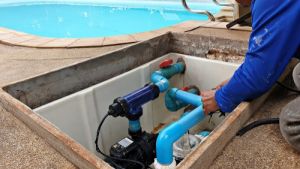Swimming is a rite of passage in Australia, which helps explain why so many of us love dipping our feet in the water, particularly during the summer months. In fact, there are more than 1.1 million residential swimming pools across the country, with around 90,000 pool pumps installed each year, according to energy.gov.au. But all that fun in the sun comes at a cost to our energy bills, especially when it comes to cleaning.
How much does it cost to run a pool pump?
The average pool pump will cost between 13c and 40c per hour to run, based on an electricity usage rate of 24.9c/kWh. This means if you run your pool for six hours per day over summer (90 days), it’ll add between $69.30 and $216.00 to your energy bills. Used consistently all year round, a pool pump could add as much as $864 to your annual bills.
Many factors contribute to pool pump running costs, including your usage rate, the size of your pool, how long you run your pool pump for, the filter type and the flow rate (litres per minute).
Pool Pump Running Costs
The table below shows the costs of running a pool pump for six hours a day over a 90-day summer period.
| Pool volume | Flow rate* (litres per minute) | Average hourly usage (watts) | Summer electricity cost (used 6hrs/day) |
|---|---|---|---|
| 34kL to 54kL | 100 to 150 L/m | 513 | $69.30 |
| 54kL to 72kL | 150 to 200 L/m | 573 | $77.40 |
| 72kL to 90kL | 200 to 250 L/m | 738 | $99.00 |
| 90kL to 108kL | 250 to 300 L/m | 906 | $121.50 |
| Over 108kL | Over 300 L/m | 1,605 | $216.00 |
Average energy consumption figures based on a selection of 17 residential pool pumps from four manufacturers. Usage cost estimates based on average electricity usage cost of 24.9c/kWh. Average usage cost based on single rate plans on Canstar Blue’s database, available for an annual usage of 4,200kWh. *Based on the Flow Rate required to pump the applicable pool volume in six hours.
Pool Pump Hourly Running Costs
Here are the average hourly running costs for pool pumps. Using the example of a pool size of 54 to 72kL, running a pool pump for six hours a day will add approximately $313.90 to your annual power bill.
| Pool volume/Flow rate | Flow rate* (Litres per minute) | 1 hour use | 4 hours use | 6 hours use |
|---|---|---|---|---|
| 34-54kL | 100-150 L/m | 513 | $0.13 | $0.51 | $0.77 |
| 54-72kL | 150-200 L/m | 573 | $0.14 | $0.57 | $0.86 |
| 72-90kL | 200-250 L/m | 738 | $0.18 | $0.74 | $1.10 |
| 90-108kL | 250-300 L/m | 906 | $0.23 | $0.90 | $1.35 |
| Over 108kL | Over 300 L/m | 1,605 | $0.40 | $1.60 | $2.40 |
Average energy consumption figures based on a selection of 17 residential pool pumps from four manufacturers. Usage cost estimates based on average electricity usage cost of 24.9c/kWh. Average usage cost based on single rate plans on Canstar Blue’s database, available for an annual usage of 4,200kWh. *Based on the Flow Rate required to pump the applicable pool volume in six hours.
Pool pump running costs per state and tariff
The following table shows the average summer costs (90 days) of using a pool pump for six hours a day. Figures are calculated across each state and tariff type for a 36-54kL pool.
| State | Single rate | Controlled load 1 | Controlled load 2 |
|---|---|---|---|
| NSW | $69.53 | $40.72 | $42.94 |
| VIC | $68.42 | $49.50 | N/A* |
| QLD | $58.17 | $44.60 | $47.09 |
| SA | $90.86 | $52.08 | $N/A* |
| TAS | $69.81 | $37.12 | $48.20 |
| ACT | $57.07 | $37.95 | $44.32 |
Based on average hourly energy consumption of 513W. per a selection of residential pool pumps with flow rates of 100 to 150 litres per minute. Based on average usage costs per plans on Canstar Blue’s database, available for an annual usage of 4,200kWh. *Victoria and South Australia only have one type of controlled load tariff.
Cheap Energy Deals
Here are some of the cheapest published deals from the retailers on our database that include a link to the retailer’s website for further details. These are products from referral partners†. These costs are based on the Ausgrid network in Sydney but prices may vary depending on your circumstances. This comparison assumes general energy usage of 3900kWh/year for a residential customer on a single rate tariff. Please use our comparison tool for a specific comparison in your area. Our database may not cover all deals in your area. As always, check all details of any plan directly with the retailer before making a purchase decision.
Here are some of the cheapest published deals from the retailers on our database that include a link to the retailer’s website for further details. These are products from referral partners†. These costs are based on the Citipower network in Melbourne but prices may vary depending on your circumstances. This comparison assumes general energy usage of 4000kWh/year for a residential customer on a single rate tariff. Please use our comparison tool for a specific comparison in your area. Our database may not cover all deals in your area. As always, check all details of any plan directly with the retailer before making a purchase decision.
Here are some of the cheapest published deals from the retailers on our database that include a link to the retailer’s website for further details. These are products from referral partners†. These costs are based on the Energex network in Brisbane but prices may vary depending on your circumstances. This comparison assumes general energy usage of 4600kWh/year for a residential customer on a single rate tariff. Please use our comparison tool for a specific comparison in your area. Our database may not cover all deals in your area. As always, check all details of any plan directly with the retailer before making a purchase decision.
Here are some of the cheapest published deals from the retailers on our database that include a link to the retailer’s website for further details. These are products from referral partners†. These costs are based on the SA Power network in Adelaide but prices may vary depending on your circumstances. This comparison assumes general energy usage of 4000kWh/year for a residential customer on a single rate tariff. Please use our comparison tool for a specific comparison in your area. Our database may not cover all deals in your area. As always, check all details of any plan directly with the retailer before making a purchase decision.
Is it cheaper to run a pool pump at night?

Running a pool pump at night will only be cheaper if you’re connected to a time of use tariff where off-peak rates are usually charged overnight. Most pool pumps will be connected to a controlled load tariff whereby it is metered separately (normally at a lower rate) to the rest of your property.
If your pool pump is on a single rate tariff it will be charged the same rate no matter what time of day it is. Depending on the state, there may be two types of controlled load tariffs. Your electricity distributor is responsible for choosing which hours power is supplied, which is typically around eight to 18 hours a day during non-peak energy demand periods.
Which pool pump is cheapest to run?
Pool pumps come in all different shapes and sizes, so working out which type is cheapest to run can be pretty challenging. Here are the types of pump pumps as a general guide of a what is cheapest and most expensive to run.
- Single speed: This type of pump is generally the most affordable to buy outright, but the most expensive to run, as it only operates off one speed.
- Dual speed: Two different speeds with varying outputs, meaning lower speeds use less energy but usually take more time to run.
- Multiple/variable speed: Latest technology in pool pumps that allow users to adjust and control the speed, making them more affordable to run.
How many hours a day should you run your pool pump?
A pool pump will typically run for between six and eight hours a day, but this will depend on how long it takes to circulate, clean and filter the water. The size of pool and type of pump will also impact how many hours it will take to run.
It’s important to note that pool pumps may take longer to run in summer compared to winter, as seasonal factors come into play, like climate and foliage in pool. Finally, how much activity your pool gets, and if you have a pool cover can also affect the time it takes to properly clean.
The final word on pool pumps
A pool pump is one of the most energy-draining appliances in the home so it’s worth knowing how much you’re paying to run your pool efficiently. This guide should give you a rough estimate as to what you can expect to pay on top of your annual power bills. If you’re thinking about upgrading to a more energy-efficient pool pump or buying a property with a pool, make sure you take into account what you’re currently paying for electricity usage.
Image credits: dvoevnore/Shutterstock.com, B Ledger/Shutterstock.com



Share this article